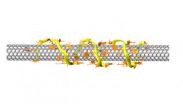(Press-News.org) DNA, a molecule famous for storing the genetic blueprints for all living things, can do other things as well. In a new paper,* researchers at the National Institute of Standards and Technology (NIST) describe how tailored single strands of DNA can be used to purify the highly desired "armchair" form of carbon nanotubes. Armchair-form single wall carbon nanotubes are needed to make "quantum wires" for low-loss, long distance electricity transmission and wiring.
Single-wall carbon nanotubes are usually about a nanometer in diameter, but they can be millions of nanometers in length. It's as if you took a one-atom-thick sheet of carbon atoms, arranged in a hexagonal pattern, and curled it into a cylinder, like rolling up a piece of chicken wire. If you've tried the latter, you know that there are many possibilities, depending on how carefully you match up the edges, from neat, perfectly matched rows of hexagons ringing the cylinder, to rows that wrap in spirals at various angles—"chiralities" in chemist-speak.
Chirality plays an important role in nanotube properties. Most behave like semiconductors, but a few are metals. One special chiral form—the so-called "armchair carbon nanotube"**—behaves like a pure metal and is the ideal quantum wire, according to NIST researcher Xiaomin Tu.
Armchair carbon nanotubes could revolutionize electric power systems, large and small, Tu says. Wires made from them are predicted to conduct electricity 10 times better than copper, with far less loss, at a sixth the weight. But researchers face two obstacles: producing totally pure starting samples of armchair nanotubes, and "cloning" them for mass production. The first challenge, as the authors note, has been "an elusive goal."
Separating one particular chirality of nanotube from all others starts with coating them to get them to disperse in solution, as, left to themselves, they'll clump together in a dark mass. A variety of materials have been used as dispersants, including polymers, proteins and DNA. The NIST trick is to select a DNA strand that has a particular affinity for the desired type of nanotube. In earlier work,*** team leader Ming Zheng and colleagues demonstrated DNA strands that could select for one of the semiconductor forms of carbon nanotubes, an easier target. In this new paper, the group describes how they methodically stepped through simple mutations of the semiconductor-friendly DNA to "evolve" a pattern that preferred the metallic armchair nanotubes instead.
"We believe that what happens is that, with the right nanotube, the DNA wraps helically around the tube," explains Constantine Khripin, "and the DNA nucleotide bases can connect with each other in a way similar to how they bond in double-stranded DNA." According to Zheng, "The DNA forms this tight barrel around the nanotube. I love this idea because it's kind of a lock and key. The armchair nanotube is a key that fits inside this DNA structure—you have this kind of molecular recognition."
Once the target nanotubes are enveloped with the DNA, standard chemistry techniques such as chromatography can be used to separate them from the mix with high efficiency.
"Now that we have these pure nanotube samples," says team member Angela Hight Walker, "we can probe the underlying physics of these materials to further understand their unique properties. As an example, some optical features once thought to be indicative of metallic carbon nanotubes are not present in these armchair samples."
INFORMATION:
* X. Tu, A.R. Hight Walker, C.Y. Khripin and M. Zheng. Evolution of DNA sequences towards recognition of metallic armchair carbon nanotubes. J. Am. Chem. Soc., Just Accepted Manuscript, Web publication: July 21, 2011.
** From the distinctive shape of the edge of the cylinder.
*** X. Tu, S. Manohar, A. Jagota and M. Zheng. DNA sequence motifs for structure-specific recognition and separation of carbon nanotubes. Nature, 460, 250-253, July 9, 2009.
Armchair science: DNA strands that select nanotubes are first step to a practical 'quantum wire'
2011-08-04
ELSE PRESS RELEASES FROM THIS DATE:
University of Miami business professor helps create a successful scheduling method for umpires in Major League Baseball
2011-08-04
Scheduling umpire crews in Major League Baseball (MLB) can be a daunting task. However, Tallys Yunes, assistant professor of management science at the University of Miami School of Business Administration and his collaborators have created a novel solution. The team developed an efficient method to generate high-quality schedules for the MLB.
The study is titled "Scheduling Major League Baseball Umpires and the Traveling Umpire Problem" published online ahead of print by the journal Interfaces, a popular outlet for practitioners in the field of Operations Research.
...
Research helps breeders really know their onions to enhance global food security
2011-08-04
Research led by the Warwick Crop Centre in the School of Life Sciences at the University of Warwick has developed a unique collection of information about the disease resistance of 96 of the world's onion varieties. It will be a crucial resource for commercial growers and seed producers trying to combat one of the most difficult diseases affecting onion crops. This work may also have benefits in terms of and reduced fertiliser consumption and enhanced drought tolerance.
The work on onions in this research funded by Defra (The Department for Environment, Food and Rural ...
Predicting perilous plaque in coronary arteries via fluid dynamics
2011-08-04
Researchers at Emory and Georgia Tech have developed a method for predicting which areas of the coronary arteries will develop more atherosclerotic plaque over time, based on intracoronary ultrasound and blood flow measurements.
The method could help doctors identify "vulnerable plaque," unstable plaque that is likely to cause a heart attack or stroke. It involves calculating shear stress, or how hard the blood tugs on the walls of the arteries, based on the geometry of the arteries and how fast the blood is moving.
The results were posted online this week in the journal ...
Aggressive drug therapy aids superbug evolution
2011-08-04
New research raises troubling concerns about the use of aggressive drug therapies to treat a wide range of diseases such as MRSA, C. difficile, malaria, and even cancer.
"The universally accepted strategy of aggressive medication to kill all targeted disease pathogens has the problematic consequence of giving any drug-resistant disease pathogens that are present the greatest possible evolutionary advantage," says Troy Day, one of the paper's co-authors and Canada Research Chair in Mathematical Biology at Queen's.
The researchers note that while the first aim of a drug ...
Finding could reduce antibiotic use in critically ill patients
2011-08-04
Measuring the levels of a natural body chemical may allow doctors to reduce the duration of antibiotic use and improve the health outcomes of critically ill patients.
"Infection is a common and expensive complication of critical illness and we're trying to find ways to improve the outcomes of sick, elderly patients and, at the same time, reduce health care costs," says Daren Heyland, a professor of Medicine at Queen's, director of the Clinical Evaluation Research Unit at Kingston General Hospital, and scientific director of the Technology Evaluation in the Elderly Network.
Prolonged ...
Harnessing the power of positive thoughts and emotions to treat depression
2011-08-04
New Rochelle, NY, August 3, 2011—Positive activity interventions (PAIs) offer a safe, low-cost, and self-administered approach to managing depression and may offer hope to individuals with depressive disorders who do not respond or have access to adequate medical therapy, according to a comprehensive review article in The Journal of Alternative and Complementary Medicine, a peer-reviewed journal published by Mary Ann Liebert, Inc. The article, "Delivering Happiness: Translating Positive Psychology Intervention Research for Treating Major and Minor Depressive Disorders" ...
Virginia Tech professors publish research on post-traumatic stress
2011-08-04
In the months after the April 16, 2007, shootings at Virginia Tech, two professors administered a survey to assess posttraumatic stress among students. The findings have been published in the July 18, 2011 issue of the Journal of Psychological Trauma: Theory, Research, Practice, and Policy, published by the American Psychological Association.
According to researchers Michael Hughes, professor of sociology in the College of Liberal Arts and Human Sciences, and Russell T. Jones, professor of psychology in the College of Science, 15.4 percent of Virginia Tech students experienced ...
Raptor usurpers in neighboring habitats reshape the conventional wisdom
2011-08-04
When we make plans that will change a natural environment — whether it's building a new shopping mall or planting a new forest — surveyors dutifully assess the environmental risks to plant and animal life in the region. But what's environmentally good for one area may be an environmental disaster for an adjacent one, a Tel Aviv University researcher cautions.
When displaced by these projects, indigenous species migrate to neighboring habitats, says Guilad Friedemann, a PhD student at TAU's Department of Zoology in the George S. Wise Faculty of Life Sciences. This has ...
Getting to the heart of the appeal of video games
2011-08-04
People spend 3 billion hours a week playing videogames but little is known scientifically about why they are actually fun in the first place.
The vast majority of research into videogames has concentrated on the possible harmful effects of playing videogames, ignoring the simple question of why people actually want to play them.
But new research led by scientists at the University of Essex sheds some light on the appeal of videogames and why millions of people around the world find playing them so much fun.
The study investigated the idea that many people enjoy playing ...
UI biologist finds one species of pathogen can produce two distinct biofilms
2011-08-04
Many medical devices, ranging from artificial hip joints to dentures and catheters, become sites for unwelcome guests -- complex communities of microbial pathogens called biofilms that are resistant to the human immune system and antibiotics, thus proving a serious threat to human health.
However, researchers may have a new way of looking at biofilms, thanks to a study conducted by University of Iowa biologist David Soll and his colleagues published in the Aug. 2 issue of the online, open access journal PLoS Biology.
Previously, researchers believed that each pathogen ...





